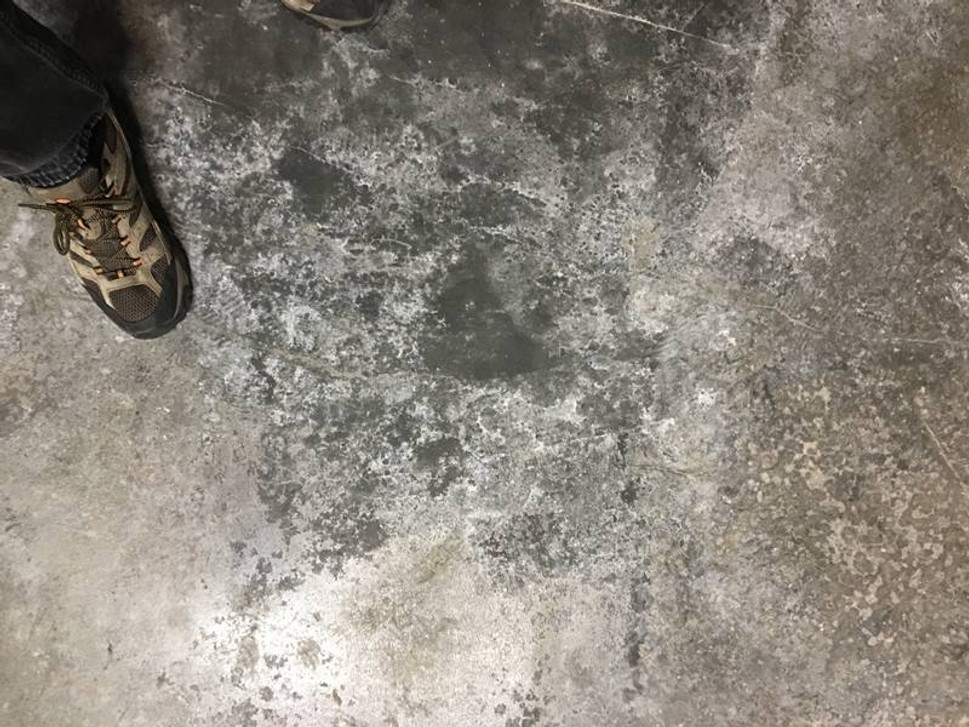Humidity transfers from the cold humid environment (outside concrete foundation wall or floor) to a dry warm environment (inside your basement) through the concrete foundation walls. It is common to have a basement that is not finished show no humidity problems, but as a soon as the inside of the basement is warmed by the air-conditioning unit it will start drawing humidity through the floor and the walls if untreated. Air conditioning systems warm the air by drawing all the cold moisture out of the air. This dries the room and starts pulling moisture from concrete floors and walls. A common solution to this problem is to put dehumidifiers into basements. These simply draw more moisture through the floor and the walls exacerbating the humidity problems.
How to Recognise Humidity In Concrete - Video
There are many sealers in the industry penetrating, acrylics, epoxies, polyurethanes, etc. (Concrete Sealer Types) They are all designed for special purposes so before sealing concrete it is important to define the purpose of why you are sealing.
- When you are addressing humidity problems in concrete you have to select a sealer that will stop the humid molecules from transferring through the floor as well as allowing the concrete to breathe to prevent sealer failure.
- All sealers with moisture vapor barrier capabilities have a maximum limit to stop humidity transfer. This is why a humidity test is important before a sealer is applied. A humidity test will provide a number that can be easily related to the vapor barrier capabilities of the sealer.
The typical signs of a basement or inside floor with humidity problems are:
1. Humidity smell
2. White powder on the floor (efflorescence – humidity is leaching salts from the concrete to the surface)
3. Paint peeling off the floor
4. Random dark areas on the concrete surface
5. When a plastic container is set on top of concrete after a few days it leaves a humid spot under the item.
6. Vinyl floor peeling off the floor
7. Loose ceramic tiles or white powder showing on the grout.
8. Carpet padding melting or sticking to the co Humidity transfers from the cold humid environment (outside concrete foundation wall or floor) to a dry warm environment (inside your basement) through the concrete foundation walls. It is common to have a basement that is not finished show no humidity problems, but as a soon as the inside of the basement is warmed by the air-conditioning unit it will start drawing humidity through the floor and the walls if untreated. Air conditioning systems warm the air by drawing all the cold moisture out of the air. This dries the room and starts pulling moisture from concrete floors and walls. A common solution to this problem is to put dehumidifiers into basements. These simply draw more moisture through the floor and the walls exacerbating the humidity problems.
There are many sealers in the industry penetrating, acrylics, epoxies, polyurethanes, etc. (Concrete Sealer Types) They are all designed for special purposes so before sealing concrete it is important to define the purpose of why you are sealing.
- When you are addressing humidity problems in concrete you have to select a sealer that will stop the humid molecules from transferring through the floor as well as allowing the concrete to breathe to prevent sealer failure.
- All sealers with moisture vapor barrier capabilities have a maximum limit to stop humidity transfer. This is why a humidity test is important before a sealer is applied. A humidity test will provide a number that can be easily related to the vapor barrier capabilities of the sealer.
The typical signs of a basement or inside floor with humidity problems are:
1. Humidity smell
2. White powder on the floor (efflorescence – humidity is leaching salts from the concrete to the surface)
3. Paint peeling off the floor
4. Random dark areas on the concrete surface
5. When a plastic container is set on top of concrete after a few days it leaves a humid spot under the item.
6. Vinyl floor peeling off the floor
7. Loose ceramic tiles or white powder showing on the grout.
8. Carpet padding melting or sticking to the con ncrete surface creating a strange smell
You get these benefits from sealing your inside or basement concrete floors:
1. Can provide a beautiful stained floor (Basement Pictures in Photo Album)
2. Eliminates the problem of having carpet in the basement
3. Easy and simple to clean and maintain
4. Eliminate humidity and reduce Radon Gas in the basement (Radon gas is transferred into the basement on the moisture vapor transfer).
5. Total green flooring solution (no solvents)
6. Easy to clean up pet accidents – no smell entrapped in concrete
7. Healthier environment because floor does not dust
8. Healthier environment which mitigates mold growth when the floor is covered with a rug or carpet
9. More light reflectivity from the floor
10. Not damageable from flood waters
11. By mitigating humidity you will create a warmer environment
12. Sealed walls can be painted any color to enhance the room
Easy Six Step System to solve your humidity problems and have a great usable space:
1. Test floor for humidity levels
2. Define final look – Clear , variegated or solid color
3. Prepare the floor
4. Stain floor
5. Seal floor with vapor barrier sealer
6. Seal floor with gloss sealer
Videos on how to test for humidity on a concrete floor:
Measuring Relative Humidity Humidity Surface Test Calcium Chloride Test PH Test

